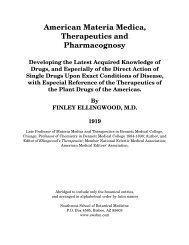SCARLET FEVER. Synonyms.—Scarlatina; Scarlet Rash. Definition ...
SCARLET FEVER. Synonyms.—Scarlatina; Scarlet Rash. Definition ...
SCARLET FEVER. Synonyms.—Scarlatina; Scarlet Rash. Definition ...
Create successful ePaper yourself
Turn your PDF publications into a flip-book with our unique Google optimized e-Paper software.
Synochoid fever is frequently complicated with local diseases, most<br />
generally of an inflammatory character; yet, as the fever is fully<br />
developed before the local disease commences, the symptoms of the<br />
latter are often very obscure.<br />
“With Predominant Affection of the Cerebro-Spinal Centers.—This forms<br />
the nervous fever of older writers, and is not an uncommon disease. The<br />
symptoms are all increased in intensity; the skin is intensely hot and<br />
pungent, especially of the head and face; the pulse is rapid, strong, and<br />
full; the breathing frequent and suspirous, and the eyes injected and<br />
suffused. There is great irritability and restlessness, with more or less<br />
intense headache, giddiness, intolerance to light and noise, and greatly<br />
increased general sensibility. Within three or four days, delirium makes<br />
its appearance, followed in a longer or shorter time by coma-vigil, coma<br />
and insensibility, and by subsultus tendinum.<br />
“In some cases, the cerebral affection being intense, we find stupor<br />
making its appearance speedily, accompanied by a slow, oppressed, and<br />
intermittent pulse. If the affection of the nervous centers is acute, the<br />
disease may terminate fatally without much disorganization of the<br />
blood; but if not, the fever rapidly assumes a typhoid character.<br />
“With Predominant Affection of the Respiratory Apparatus.—This is the<br />
most common complication of continued fever, though, generally, it<br />
exists in but a slight degree. The bronchial mucous membrane is<br />
frequently irritated, with slight implication of the lungs. This necessarily<br />
aggravates the fever, and induces farther complication by preventing<br />
proper oxygenation of the blood. The patient complains of slight<br />
oppression and difficulty of breathing, with accelerated respiration and<br />
slight cough. If bronchitis is fully developed, the difficulty of breathing<br />
is increased, and secretion is generally established early, and a mucous<br />
rhoncus is heard over the chest, upon auscultation. If much of the<br />
structure of the lung becomes diseased, the breathing is hurried,<br />
oppressed, and sometimes laborious, the sputum rounded and streaked<br />
with blood, and in a short time exhibits the characteristic rusty color of<br />
pneumonia. There are manifest symptoms of imperfect aeration of the<br />
blood, dark, dusky hue of the lips. and tongue, flushed appearance of<br />
face, oppressed circulation, and coldness of tlie extremities. With such<br />
complications, we notice that prostration is very rapid, and<br />
contamination of the fluids speedily ensues, with typhoid symptoms.<br />
Low delirium and coma are frequent attendants upon this condition.<br />
The Eclectic Practice of Medicine - PART I - Infectious Diseases - Page 258

















